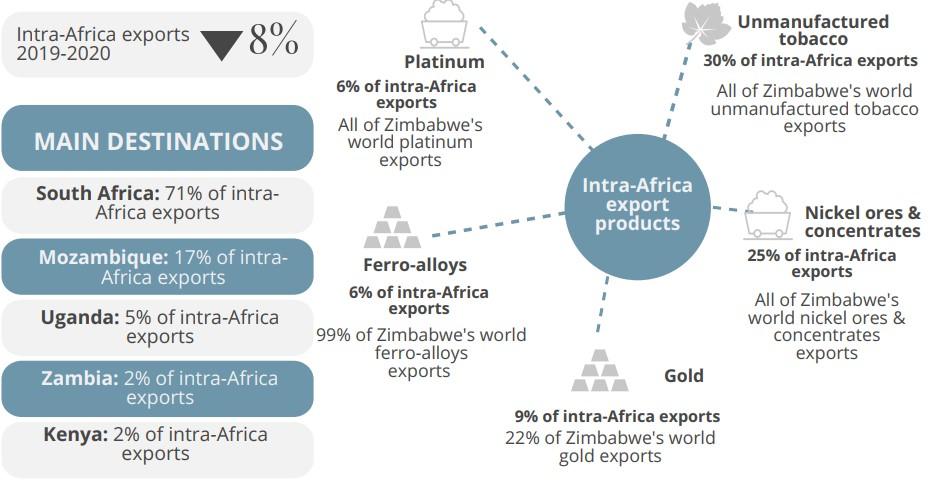When buying any product what do you really look at on the labels? How often do you check where the products were made? Who knows, maybe some of the products are made on Mars.
One thing for sure is you will come across a tag which reads: ‘Made in Zimbabwe,’ ‘Proudly manufactured in Zimbabwe’ or simply ‘Grown in Zimbabwe.’
Exports continue to grow this year thanks to the increasing popularity of Zimbabwean products in regional markets.
According to statistics recently released by ZIMSTAT, Zimbabwe’s exports grew by 12.8 per cent, from US$3.75 billion to US$4.22 billion, between January and August this year.
This growth has been anchored by export growth in emerging and non-traditional markets in countries such as United Arab Emirates (UAE), China, Belgium, and Italy.
The figures show that Zimbabwe’s products to United Arab have grown to US$1.38 billion in 2022. Exports to China also grew to around US$454 million during January-August this year, compared to the same period in 2019, where exports only amounted to around US$12 million. The Netherlands, which is Zimbabwe’s largest market for horticultural produce, has increased its imports from local exporters from around US$2.24 million during the period under review in 2019, to US$30.75 million this year. Italy has also recorded impressive growth from around US$1.49 million in 2019, to US$40.38 million in 2022. Zimbabwe’s exports to Belgium have almost doubled from US$47.78 million in 2019, to US$82.26 million this year.
Meanwhile, countries such as the Democratic Republic of Congo (DRC), Mozambique, Botswana, Zambia, and Malawi have been identified as having potential following participation of local industry in trade promotion events in these markets.
There is also inward buyer missions which are said to be export promotion activities designed to boost the confidence of the international business community in the local industry.
Inward buyer missions are export promotion activities designed to boost the confidence of the international business community in the local industry. Invited buyers from targeted markets engage in business-to-business meetings with local companies to discuss such issues as order quantities, prices, and other specific requirements. During the missions, the buyers will also visit local industries to appreciate the local productive capacity and processes.
ZimTrade Chairperson, Clara Mlambo, urged local companies to take advantage of Inward buyer missions to identify potential business partners that will drive their exports into the region.
“Considering the amount of work and financial commitment that is required to identify potential partners in export markets, local private sector must take full advantage of the Inward Buyer Mission to connect with reliable buyers and distributors,” said Mlambo.
“Zimbabwe is strategically located at the heart of southern Africa, and this offers us many advantages, especially on logistics where our products can land in neighboring countries at a competitive price.”
Zimbabwe lies in Southern Africa, between the Limpopo and Zambezi rivers. Mozambique bounds the land-locked country to the east, Zambia to the north, South Africa to the south, and to the west by Botswana.
“However, unlocking these opportunities needs us to strengthen relations between Zimbabwean companies and buyers in these markets,” she said.
Zimbabwe is a member of several regional economic communities. The southern African country is a member of the Common Market for Eastern and Southern Africa (COMESA) and the Southern African Development Community (SADC). The African Continental Free Trade Agreement (AfCFTA) entered into force on May 30, 2019.

Zimbabwe has several multi-lateral trade agreements within the block. The country has been implementing the SADC Trade Protocol since 2001.
This Protocol is an agreement between SADC Member States to reduce customs duties and other barriers to trade on products from each other.
By lowering customs duties and removing other barriers to trade, the SADC Member States intend to promote economic growth and regional integration.
For exporters within SADC Member States, they enjoy preferential tariff rates are granted to products that meet the SADC Rules of Origin and are accompanied by a SADC Certificate Origin. Zimbabwe enjoys all these benefits.
In addition, Zimbabwean exporters also enjoy trading under the COMESA Free Trade Area, designed to promote regional integration through trade development and develop their natural and human resources for the mutual benefit of all their peoples.
Zambia, and Mozambique, as observed from ZIMSTAT statistics, are picking an interest for Zimbabwe’s manufactured tobacco.
Read: Zimbabwe’s manufacturing sector dominates mergers, acquisitions in 2021
This translated to a 17 per cent increase in manufactured tobacco exports from US$35.6 million between January-August 2021 to US$41.7
Ceramic tiles exports increased from US$4 million in January-August 2021 to US$10.3 million this year.
According to ZimTrade, ceramic tiles being exported by a Mashonaland West based company have sustained the sector as they open new markets in Zambia and South Africa.
Hides and skins exports also increased by 43 per cent from US$7.7 million during the period under review last year, to US$11 million this year.
Major export products in the segment were raw hides and skins, fresh or preserved, not tanned amounting to US$10.9 million.
Processed leather exports recorded a 19 per cent growth, from US$1.2 million to US$1.4 million.
In addition, exports from packaging and stationary sector grew from US$6.3 million between January-August last year, to US$11.2 million in 2022, translating to 77 per cent increase.
The major exported products were cartons, boxes and paperboard, paper and paperboard, corrugated, creped and corrugated, creped in rolls or sheets.
The pharmaceuticals segment saw 25.7 per cent boost during this year, recording US$2.06 million compared to US$1.64 million recorded during the same period last year.
This current trade between Zimbabwe and other SADC member states shows Zimbabwe trade is quite promising. With buyers coming to Zimbabwe, they can select from a pool of products and preferences, and this benefits both parties.











